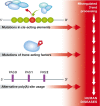mRNA 3'end processing: A tale of the tail reaches the clinic
- PMID: 24408965
- PMCID: PMC3936486
- DOI: 10.1002/emmm.201303300
mRNA 3'end processing: A tale of the tail reaches the clinic
Abstract
Recent advances reveal mRNA 3'end processing as a highly regulated process that fine-tunes posttranscriptional gene expression. This process can affect the site and/or the efficiency of 3'end processing, controlling the quality and the quantity of substrate mRNAs. The regulation of 3'end processing plays a central role in fundamental physiology such as blood coagulation and innate immunity. In addition, errors in mRNA 3'end processing have been associated with a broad spectrum of human diseases, including cancer. We summarize and discuss the paradigmatic shift in the understanding of 3'end processing as a mechanism of posttranscriptional gene regulation that has reached clinical medicine.
Figures




Similar articles
-
Transcriptome 3'end organization by PCF11 links alternative polyadenylation to formation and neuronal differentiation of neuroblastoma.Nat Commun. 2018 Dec 14;9(1):5331. doi: 10.1038/s41467-018-07580-5. Nat Commun. 2018. PMID: 30552333 Free PMC article.
-
Fungal virulence and development is regulated by alternative pre-mRNA 3'end processing in Magnaporthe oryzae.PLoS Pathog. 2011 Dec;7(12):e1002441. doi: 10.1371/journal.ppat.1002441. Epub 2011 Dec 15. PLoS Pathog. 2011. PMID: 22194688 Free PMC article.
-
The role of the 3' untranslated region in post-transcriptional regulation of protein expression in mammalian cells.RNA Biol. 2012 May;9(5):563-76. doi: 10.4161/rna.20231. Epub 2012 May 1. RNA Biol. 2012. PMID: 22614827 Review.
-
The prothrombin 3'end formation signal reveals a unique architecture that is sensitive to thrombophilic gain-of-function mutations.Blood. 2004 Jul 15;104(2):428-35. doi: 10.1182/blood-2003-08-2894. Epub 2004 Apr 1. Blood. 2004. PMID: 15059842
-
Subcellular specialization of multifaceted 3'end modifying nucleotidyltransferases.Curr Opin Cell Biol. 2012 Jun;24(3):314-22. doi: 10.1016/j.ceb.2012.03.011. Epub 2012 Apr 30. Curr Opin Cell Biol. 2012. PMID: 22551970 Review.
Cited by
-
The differential expression of alternatively polyadenylated transcripts is a common stress-induced response mechanism that modulates mammalian mRNA expression in a quantitative and qualitative fashion.RNA. 2016 Sep;22(9):1441-53. doi: 10.1261/rna.055657.115. Epub 2016 Jul 12. RNA. 2016. PMID: 27407180 Free PMC article.
-
Star-PAP, a poly(A) polymerase, functions as a tumor suppressor in an orthotopic human breast cancer model.Cell Death Dis. 2017 Feb 2;8(2):e2582. doi: 10.1038/cddis.2016.199. Cell Death Dis. 2017. PMID: 28151486 Free PMC article.
-
Targeting mRNA processing as an anticancer strategy.Nat Rev Drug Discov. 2020 Feb;19(2):112-129. doi: 10.1038/s41573-019-0042-3. Epub 2019 Sep 25. Nat Rev Drug Discov. 2020. PMID: 31554928 Review.
-
A compendium of conserved cleavage and polyadenylation events in mammalian genes.Genome Res. 2018 Oct;28(10):1427-1441. doi: 10.1101/gr.237826.118. Epub 2018 Aug 24. Genome Res. 2018. PMID: 30143597 Free PMC article.
-
Cordycepin induces apoptosis and autophagy in human neuroblastoma SK-N-SH and BE(2)-M17 cells.Oncol Lett. 2015 Jun;9(6):2541-2547. doi: 10.3892/ol.2015.3066. Epub 2015 Mar 23. Oncol Lett. 2015. PMID: 26137103 Free PMC article.
References
-
- Bennett CL, Ochs HD. IPEX is a unique X-linked syndrome characterized by immune dysfunction, polyendocrinopathy, enteropathy, and a variety of autoimmune phenomena. Curr Opin Pediatr. 2001;13:533–538. - PubMed
-
- Bennett CF, Swayze EE. RNA targeting therapeutics: molecular mechanisms of antisense oligonucleotides as a therapeutic platform. Annu Rev Pharmacol Toxicol. 2010;50:259–293. - PubMed
-
- Blechingberg J, Holm IE, Nielsen KB, Jensen TH, Jorgensen AL, Nielsen AL. Identification and characterization of GFAPkappa, a novel glial fibrillary acidic protein isoform. Glia. 2007a;55:497–507. - PubMed
Publication types
MeSH terms
Substances
LinkOut - more resources
Full Text Sources
Other Literature Sources

